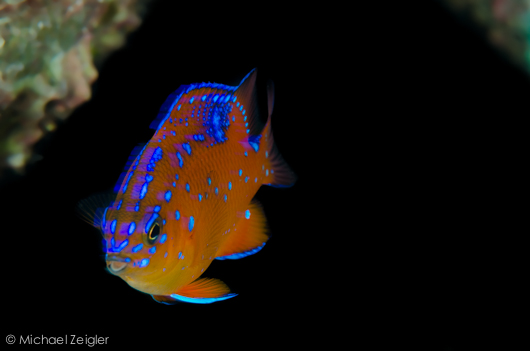Capturing the Elusive
Oct 23
Colorful, beautiful, and devilishly quick. Those are just some of the words I’ve heard people use to describe juvenile garibaldi. These tiny versions of their parents, sporting their temporary iridescent blue spots, spend their days darting in and out of the shallow reefs.
This past weekend I set out with the intent of capturing these speedy subjects, and portraying their elusive nature. But how? Certainly focusing, and then maintaining focus while they dart around would be near impossible, and frustrating to say the least. My approach: let them come to me.
These little guys and gals seem to stay in a relatively small area of the reef (at least from my observations). With that in mind, I set my dSLR to AF-C (release), utilizing the AE-L/AF-L button to focus. This would allow me to set my focal plane at a specific distance, and leave it there. By using the AE-L/AF-L button to focus, this freed up the shutter button to only release the shutter, so I could fire the trigger whenever my heart desired, whether or not the subject was in focus. This allowed me to do two things:
- By predetermining the focal distance, I could focus on another object at the same distance (a rock, for example), and then position my strobes for the ideal lighting and take test shots.
- Once the focal plane and strobes were set, I could concentrate on timing and composition.
I decided on an aperture of F22 or higher to provide the depth of field I would need to get a majority of the fish in focus.

Anything but cryptic, this juvenile looks surprised as it peers from behind its algae hide-a-way. 1/10, F25, ISO 250.
You could do the same thing with any camera by determining the distance you want to compose the image, then keep the shutter pressed halfway down until the fish came into focus. You would just have to repeat the pre-focus after each shot if you did not have a separate button for focusing.
For this shoot, I really wanted to capture and portray the speed and elusive nature of these colorful critters, so I decided to use really slow shutter speeds to show the movement (e.g. 1/1oth of a second). By setting my camera to rear-curtain sync, the camera would expose the movements of the ambient light, before the strobes would fire at the end of the exposure, therefore freezing the motion and allowing for a colorful and sharp photo.

A pair of juvies chase each other around the reef. Their speed, combined with a shutter speed of 1/1o, shows the “streaks” of their movement and brings a sense of motion to the photograph. 1/10, F22, ISO 100.
All photographs were taken with a Nikon D7000, Sea&Sea Housing, Nikon 105mm macro lens, and dual Ikelite strobes. Special thanks to Selky Charters for a great day on, and under, the water!

A young garibaldi, streaking across the frame, proudly showing off its gorgeous blue markings. 1/10, F22, ISO 100.







Related Articles
Popular Articles